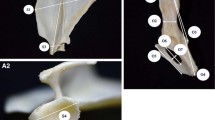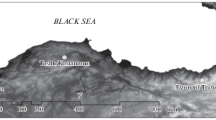Abstract
During a telemetry study, body weights and body measurements of African sand cats Felis margarita margarita were recorded in the southern provinces of Morocco between December 2015 and December 2019. In total, 41 individuals (30 males and 11 females) were captured, weighed, and the body measurements of the specimens selected for radio-collaring were recorded, with a few individuals measured in different seasons. Captured males showed higher values in all parameters measured in winter. Males weighed significantly more than females, respectively 2.16 ± 0.36 kg (N=29) and 1.70 kg ± 0.21 (N=11), and, except for ear length, which did not significantly differ between sexes, we found significant differences between males and females for every other body measurement recorded: Males have significantly longer head-and-body length, tail, neck circumference, elbow-toe-tip length, shoulder length, canines, longer and wider front paws, and longer hindfoot length than females. Differences in body weight and measurements between adult and subadult males and females are also discussed. From three recaptured individuals, we found that winter weight was on average 14% heavier than summer weight.


Similar content being viewed by others
Data availability
The dataset analysed during the current study is available from the corresponding author on reasonable request.
References
Breton G, Sliwa A, Azizi S, Essalhi A (2016) Sand cats in the Moroccan Sahara, preliminary results of a new study. Cat News 63:7–10
Brodie JF (2009) Is research effort allocated efficiently for conservation? Felidae as a global case study. Biodivers Conserv 18:2927–2939
Bufka L, Červený J (2019) Body weight and body dimensions of Eurasian lynx (Lynx lynx) in the Bohemian Forest (reintroduced “Bohemian-Bavarian-Austrian” population). Silva Gabreta, Vimperk 25:25–30
Ghadirian T, Akbari H, Besmeli M, Ghoddousi A, Hamidi AK, Dehkordi M (2016) Sand cat in Iran - present status, distribution and conservation challenges. Cat News 10(Special Issue):56–59
Goodman SM, Helmy I (1986) The sand cat Felis margarita Loche, 1858 in Egypt. Mammalia 50:120–123
Harrison DL (1972) The mammals of Arabia, vol 3. Ernest Benn, London
Hemmer H, Grubb P, Groves CP (1976) Notes on the sand cat, Felis margarita Loche, 1858. Z Säugetierk 41:286–303
Heptner VG, Sludskii AA (1992) Sand Cat Felis (Otoolobus) margarita. In: Heptner VG, Naumov NP (eds) Mammals of the Soviet Union. Vol. 2, part 2, Carnivora (Hyaenas and cats). English translation, Sci. ed. R. S. Hoffman. Smithsonian Institution Libraries and the National Science Foundation, Washington DC, pp 636–665
Howard-McCombe J, Banfield L, Kitchener AC, Al Qahtani H, Toosy A, Al Qarqas M, Craig M, Abramov AV, Véron G, Brito JC, Azizi S, Ghazali M, Breton G, Sliwa A, Kaltwaßer K, Hochkirch A, Senn H (2019) A Mitochondrial Phylogeny of the Sand Cat (Felis margarita Loche, 1858). J Mamm Evol. https://doi.org/10.1007/s10914-019-09473-w
Kitchener AC, Breitenmoser-Würsten C, Eizirik E, Gentry A, Werdelin L, Wilting A, Yamaguchi N, Abramov AV, Christiansen P, Driscoll C, Duckworth JW, Johnson W, Luo SJ, Meijaard E, O’Donoghue P, Sanderson J, Seymour K, Bruford M, Groves C, Hoffmann M, Nowell K, Timmons Z, Tobe S (2017) A revised taxonomy of the Felidae. The final report of the Cat Classification Task Force of the IUCN/ SSC Cat Specialist Group. Cat News Special Issue 11:14–15
Loche V (1858) Description d’une nouvelle espèce de Chat par M. le Capitaine Loche. Revue et Magasin de Zool Pure et Appliquée 2:49–51
Maloiy G, Kamau JMZ, Shkolnik A, Meir M, Arieli R (2009) Thermoregulation and metabolism in a small desert carnivore: the Fennec fox (Fennecus zerda) (Mammalia). J Zool 198(3):279–291
Mohammad MK, Lahony SR, Al-Rammahi HM (2013) First record of the Sand Cat, Felis margarita Loche, 1858 (Mammalia: Carnivora, Felidae), from Iraq. Zool Middle East 59(4):358–359. https://doi.org/10.1080/09397140.2013.868144
Roberts TJ (1977) The mammals of Pakistan. Ernest Benn, London
Schauenberg P (1974) Données Nouvelles sur le chat des sables Felis margarita Loche, 1858. Rev Suisse Zool 81:949–969
Schroeder MA, Robb LA (2005) Criteria for gender and age. In: Braun CE (ed) Techniques for wildlife investigations and management, 6th edn. The Wildlife Society, Bethesda, pp 303–338
Sliwa A (2004) Home range size and social organisation of black-footed cats (Felis nigripes). Mamm Biol 69:96–107
Sliwa A (2013) Felis margarita, Sand Cat, Loche, 1858. In: Kingdon JS and Hoffmann M (eds) The Mammals of Africa Vol 5. Carnivores, Pangolins, Equids and Rhinoceroses. Bloomsbury Publishing, London, pp 199–202
Sliwa A, Breton G, Chevalier F (2013) Sand cat sightings in the Moroccan Sahara. Cat News 5:28–29
Sliwa A, Ghadirian T, Appel A, Banfield L, Sher Shah M, Wacher T (2016) Felis margarita. The IUCN Red List of Threatened Species 2016: e.T8541A50651884. https://doi.org/10.2305/IUCN.UK.2016-2.RLTS.T8541A50651884.en. Accessed 25 March 2020
Stander PE (1997) Field age determination of leopards by tooth wear. Afr J Ecol 35:156–161
Sunquist M, Sunquist F (2002) Wild cats of the World. University of Chicago Press, Chicago
Wozencraft WC (2005) Order Carnivora. In: Wilson DE, Reeder DM (eds) Mammal species of the world. A taxonomic and geographic reference, 3rd edn. Johns Hopkins University Press, Baltimore, pp 532–628
Acknowledgements
The authors also thank Brahime Boupoya—for his keen involvement and adaptation to fieldwork requirements—Franck Chevalier—for his full local support—Urs and Christine Breitenmoser, Andrew Kitchener, and one anonymous reviewer—for their revision and constructive criticism of our manuscript—and Cathy Zaire for English revision.
Funding
This study was funded by the following institutions and organisations (in alphabetic order) and we are indebted to them: Association SOS Félins & Co. (FR), Big Cat Rescue (US), the Cincinnati Zoo and Botanical Gardens (US), the HCEFLCD (MA), the animal keeper class of 2015/2016 from the HELHa school (BE), the International Society for Endangered Cats (CA), le Jardin Zoologique de Rabat (MA), le Jardin Zoologique de Lyon (FR), Panthera (US/FR), Parken Zoo Eskilstuna (SE), the Royal Zoological Society of Scotland (UK), and Zoologischer Garten Köln Zoo (DE).
Author information
Authors and Affiliations
Contributions
This study was designed by Alexander Sliwa and Grégory Breton. All authors physically and materially contributed in this research by conducting the fieldwork activities, including data collection. Data were analysed by Grégory Breton. The first draft of this manuscript was written by Grégory Breton and Alexander Sliwa commented on all versions of the manuscript. All authors read and approved the final version of this article before publication.
Corresponding author
Ethics declarations
Disclosure statement
This study was carried out with the approval of the High Commission for Water, Forests, and the Fight against Desertification of the Kingdom of Morocco (hereafter abbreviated HCEFLCD), in the frame of two partnership agreements for the conservation of wild desert carnivores, between the Rabat Zoological Park and the “Parc des Félins” zoological park, France, in 2015, and between the HCEFLCD, Rabat Zoological Park, Panthera France, and Kölner/Cologne Zoo, Germany. This study fell under the research permits No. 08/2015 of 09/03/2015, No. 08/2017 of 30/03/2017, and No. 28/2018 of 20/07/18 by the HCEFLCD.
Research involving animals
All live sand cat capture and handling techniques used by the authors complied with the highest standards of animal welfare and followed the ethical standards of the Ethical Treatment of Animals in Applied Animal Behaviour Research of the ISAE. More specifically, our methods of capture and handling did not injure or caused excessive stress to the animals and during their anaesthesia measures were taken to ensure that the animals were protected from predation and temperature drop until their recovery.
Competing interests
The authors declare no competing interests.
Disclaimer
Apart from the authors, the funding sources were not involved in the study design; in the collection, analysis, and interpretation of data; in the preparation of the manuscript; nor the decision to submit the article for publication.
Additional information
Communicated by: Krzysztof Schmidt
Publisher’s note
Springer Nature remains neutral with regard to jurisdictional claims in published maps and institutional affiliations.
Supplementary information
ESM 1
(DOCX 2715 kb)
Rights and permissions
About this article
Cite this article
Breton, G., Azizi, S., Zine Eddine, M. et al. Body weights and measurements of African sand cats (Felis margarita margarita). Mamm Res 67, 279–285 (2022). https://doi.org/10.1007/s13364-022-00628-4
Received:
Accepted:
Published:
Issue Date:
DOI: https://doi.org/10.1007/s13364-022-00628-4




